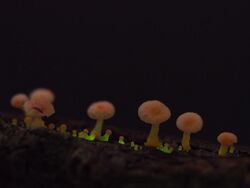Mycena roseoflava
Topic: Biology
 From HandWiki - Reading time: 3 min
From HandWiki - Reading time: 3 min
| Mycena roseoflava | |
|---|---|

| |
| Bioluminescent Mycena roseoflava found throughout New Zealand | |
| Scientific classification | |
| Domain: | Eukaryota |
| Kingdom: | Fungi |
| Division: | Basidiomycota |
| Class: | Agaricomycetes |
| Order: | Agaricales |
| Family: | Mycenaceae |
| Genus: | Mycena |
| Species: | M. roseoflava
|
| Binomial name | |
| Mycena roseoflava G. Stev.
| |
| Synonyms | |
|
Insiticia roseoflava (G. Stev.) E. Horak | |
Mycena roseoflava is a species of agaric mushroom in the family Mycenaceae.[1][2] It was first discovered in 1964 by New Zealand mycologist Greta Stevenson.[3][1][4] It is a wood-inhabiting mushroom native to New Zealand.[5][6]
The small fungus is saprotrophic, meaning it gains nutrients from decaying organic matter and appears on stressed or dying plants, often found on rotting wood and twigs. As matter decomposes within a medium in which a saprotroph is residing, the saprotroph breaks such matter down into its composites.
M. roseoflava has white spores with small white caps, normally standing at a height of 5-10 millimeters and an equal width. It is most active in the autumn season and is not considered edible.[7][3] The stem relatively short is often attached to the side of wood, usually with a slightly swollen stem base. It is rare to see in Victoria, where it has only found only in wetter forests and rainforests, but is somewhat common in Tasmania.[8]
In the first descriptions of the mushroom, Stevenson noted the caps were "pink fading yellowish, hemispherical with a shallow central umbilicus." The texture of the caps were smooth to minutely floccose. The gills were described as adnate to slightly concurrent. The spores were observed to be globose, amyloid, and thin-walled.[3]
In 2021, the species was discovered to be bioluminescent, this never having been recorded previously.[9] According to New Zealand Fungarium curator Dr. Maj Padamsee, "It could have been found before but it just hadn’t been recorded – people who had been out in the forest might have seen something because it’s not very bright… it’s a very pale light colour." The enzymes produced from the compound luciferin gives the mushrooms their glow, as it also does with fireflies and some marine organisms.[10][5] The discovery of bioluminescence was made during an event dedicated to studying fungus that took place on Stewart Island.[11][12]
References
- ↑ 1.0 1.1 Stevenson, Greta (1982) (in en). Field Guide to Fungi. University of Canterbury. ISBN 978-0-900392-30-6. https://books.google.com/books?id=G0W4AAAAIAAJ.
- ↑ "Mycena roseoflava G. Stev., Kew Bull. 19(1): 50 (1964)". http://www.speciesfungorum.org/Names/NamesRecord.asp?RecordID=334635.
- ↑ 3.0 3.1 3.2 Stevenson, Greta (1964). "The Agaricales of New Zealand: V". Kew Bulletin 19 (1): 1–59. doi:10.2307/4108283. ISSN 0075-5974. https://www.jstor.org/stable/4108283.
- ↑ Segedin, Barbara P. (1987-04-01). "An annotated checklist of Agarics and Boleti recorded from New Zealand". New Zealand Journal of Botany 25 (2): 185–215. doi:10.1080/0028825X.1987.10410067. ISSN 0028-825X. https://doi.org/10.1080/0028825X.1987.10410067.
- ↑ 5.0 5.1 "Glowing fungi, a new rust highlights of expedition" (in en). 2021-05-12. https://www.odt.co.nz/regions/southland/glowing-fungi-new-rust-highlights-expedition.
- ↑ "Mycena roseoflava G. Stev. 1964 - Biota of NZ". https://biotanz.landcareresearch.co.nz/scientific-names/1cb19456-36b9-11d5-9548-00d0592d548c.
- ↑ "Mycena roseoflava". https://hiddenforest.co.nz/fungi/family/mycenaceae/mycen11.htm.
- ↑ T.E.R:R.A.I.N. 2019 Taranaki Educational Resource: Research, Analysis and Information Network. Accessed 11 April 2019
- ↑ "Native Mycena roseoflava fungi photographed glowing with bioluminescence" (in en-nz). 2021-05-13. https://www.rnz.co.nz/news/national/442522/native-mycena-roseoflava-fungi-photographed-glowing-with-bioluminescence.
- ↑ "Native Mycena roseoflava fungi photographed glowing with bioluminescence". May 13, 2021. https://www.msn.com/en-nz/news/national/native-mycena-roseoflava-fungi-photographed-glowing-with-bioluminescence/ar-BB1gGvO2.
- ↑ "Native Mycena Roseoflava fungi photographed glowing with bioluminescence" (in en-NZ). May 16, 2021. https://www.nzgeo.com/audio/native-mycena-roseoflava-fungi-photographed-glowing-with-bioluminescence/.
- ↑ "Glowing fungi and new rust species among Fungal Foray finds" (in en-US). https://www.landcareresearch.co.nz/news/glowing-fungi-and-new-rust-species-among-fungal-foray-finds/.
Wikidata ☰ Q10536024 entry
 |
 KSF
KSF